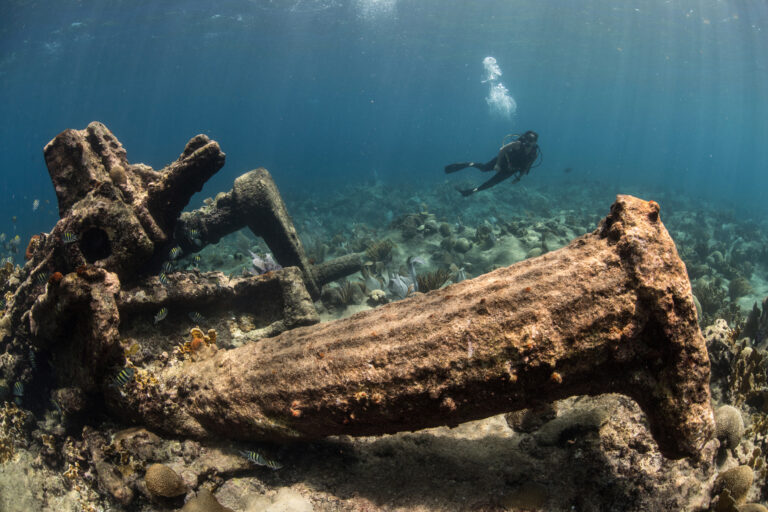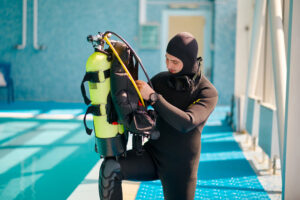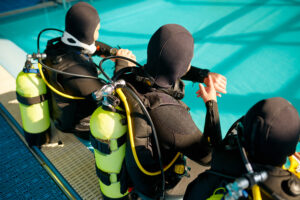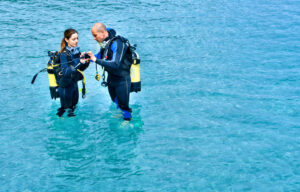What is Immersion Hypothermia?
Immersion hypothermia occurs when the body’s core temperature drops significantly due to prolonged exposure to cold water. This condition is particularly relevant to scuba divers, who often spend extended periods in environments where the water temperature can quickly lead to substantial heat loss. Understanding immersion hypothermia is crucial for divers, as it can lead to severe health consequences if not promptly recognized and treated.
The Physiology of Immersion Hypothermia
The human body maintains a core temperature around 37°C (98.6°F) through a balance of heat production and heat loss. Immersion in cold water disrupts this balance, as water conducts heat away from the body much more efficiently than air. Even water that feels moderately cold can cause hypothermia if exposure is prolonged. The body’s initial response to cold water immersion is vasoconstriction, where blood vessels near the skin narrow to reduce heat loss. Shivering also begins as an involuntary response to generate heat through muscle activity. However, these mechanisms are only effective for short periods.
As cold exposure continues, the body prioritizes protecting vital organs, leading to reduced blood flow to the extremities. This can cause a dangerous drop in overall body temperature. The rate of heat loss in water is about 25 times greater than in air of the same temperature, making hypothermia a significant risk for scuba divers. Factors such as water temperature, immersion duration, and the diver’s physical condition can all influence the onset and severity of hypothermia.
Immersion hypothermia affects the central nervous system, leading to impaired cognitive and motor functions. As the core temperature drops, the body’s metabolic processes slow down, which can result in decreased oxygen consumption and reduced heart rate. In severe cases, the body’s attempt to conserve heat can lead to life-threatening conditions such as cardiac arrest.
Risk Factors
Several factors increase the risk of immersion hypothermia for scuba divers. The most obvious is water temperature. Even relatively warm water, around 21°C (70°F), can cause hypothermia if exposure is prolonged. Divers in colder waters, particularly below 10°C (50°F), are at a higher risk, especially if they are not adequately protected. The diver’s physical condition also plays a crucial role. Individuals with lower body fat, reduced muscle mass, or poor physical fitness are more susceptible to heat loss and, consequently, hypothermia.
The type of diving gear used significantly impacts heat retention. Wetsuits and drysuits provide insulation, but their effectiveness depends on the material, fit, and condition of the suit. A well-fitted drysuit offers better protection against cold water, whereas a wetsuit relies on a thin layer of water trapped between the suit and the skin, which can be heated by the body. However, if the wetsuit is loose or damaged, its insulating properties are compromised.
The duration of the dive is another critical factor. The longer a diver stays submerged, the greater the risk of hypothermia. Planning dives to minimize exposure time, especially in cold water, is essential. Additionally, factors like the diver’s activity level, which affects internal heat production, and the presence of wind or currents, which can increase heat loss, should be considered when assessing the risk of hypothermia.
Symptoms and Stages of Immersion Hypothermia
The symptoms of immersion hypothermia progress through several stages, each with increasing severity. Early signs include shivering, numbness, and fatigue. Shivering is the body’s primary response to generate heat through muscle activity, but as hypothermia progresses, shivering becomes less effective, and other symptoms emerge. Numbness and tingling in the extremities can indicate reduced blood flow, a precursor to more severe hypothermia.
As the condition worsens, symptoms become more pronounced. Loss of motor coordination, slurred speech, and confusion are indicative of moderate hypothermia. These symptoms result from the cooling of the central nervous system, which affects both cognitive and physical functions. Divers experiencing these signs may have difficulty with tasks requiring fine motor skills, such as handling equipment or navigating underwater.
Severe hypothermia occurs when the core temperature drops significantly below normal levels. Symptoms at this stage include profound confusion, unconsciousness, and in extreme cases, cardiac arrest. The body’s metabolic processes slow dramatically, and vital organs may begin to fail. Recognizing and treating hypothermia before it reaches this stage is critical, as severe hypothermia requires immediate medical intervention and can be life-threatening.
Prevention Strategies
Preventing immersion hypothermia begins with proper thermal protection. Divers should use wetsuits or drysuits appropriate for the water temperature. A drysuit offers the best protection in very cold water, while a wetsuit may be sufficient in warmer conditions. The suit should fit well to ensure maximum insulation. Layering undergarments inside a drysuit can provide additional warmth, and using accessories like hoods, gloves, and boots can help protect extremities.
Physical preparation is also important. Divers should be in good physical condition, as fitness levels can influence the body’s ability to generate heat. Staying hydrated and well-nourished before a dive can help maintain energy levels and improve overall thermal regulation. Pre-dive warm-ups can also be beneficial in preparing the body for cold water exposure.
Planning is essential to minimize the risk of hypothermia. Divers should limit their time in cold water and plan dives based on the conditions. Post-dive procedures are equally important. Removing wet gear and drying off immediately after exiting the water can help retain body heat. Consuming warm beverages and finding shelter from wind and cold can further prevent heat loss.
Treatment and First Aid
Treating immersion hypothermia involves immediate and effective actions. If a diver shows symptoms of hypothermia, the first step is to remove them from the cold water. Gently handle the individual to avoid sudden movements that could trigger cardiac issues. Once out of the water, remove wet clothing and replace it with dry, warm layers to reduce further heat loss.
Rewarming the individual is the next priority. Passive rewarming, such as using blankets and warm, dry clothing, helps the body regain heat. Active rewarming techniques, such as using warm water bottles or heating pads, should be applied with caution to avoid burns or shock. For moderate to severe hypothermia, seeking medical assistance is crucial, as professional medical treatment may involve advanced warming techniques and monitoring for complications.
In severe cases, hypothermia can lead to unconsciousness and cardiac arrest. Immediate first aid measures, such as CPR, may be necessary. It’s important to continue warming efforts even if the person appears unresponsive, as hypothermic individuals can sometimes be resuscitated after prolonged efforts.
Key Takeaways
Understanding immersion hypothermia is essential for scuba divers to stay safe in cold water environments. Recognizing the risk factors, symptoms, and appropriate prevention strategies can help divers avoid this potentially life-threatening condition. Immediate and effective treatment is crucial when symptoms are detected. Proper preparation, equipment, and knowledge are key to ensuring safe and enjoyable diving experiences.

















